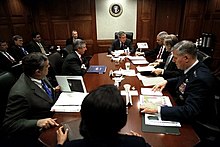
Ribbon-cutting ceremony for the newly-renovated Situation Room on May 18, 2007
Origin and staff
The Situation Room staff is organized around five Watch Teams that monitor domestic and international events. Each Watch Team includes three Duty Officers, a communications assistant, and an intelligence analyst; though the number and composition of the teams may vary, depending on shift requirements and workload. The teams are staffed from a pool of approximately 30 senior personnel from various agencies in the intelligence community and from the military. These members are handpicked from heavily vetted nominations made by their parent agencies, and are strictly apolitical. They stand watch on a 24-hour basis, constantly monitoring world events and keeping senior White House staff apprised of significant incidents.
Functions
The day begins with the Watch Team's preparation of the Morning Book. Prepared for the President, Vice President, and most senior White House staff, the Morning Book contains a copy of the National Intelligence Daily, the State Department's Morning Summary, and diplomatic cables and intelligence reports. The Morning Book is usually in the car when the National Security Advisor is picked up for work. The morning routine also includes the President's Daily Brief, which is prepared by the Office of the Director of National Intelligence, hand-delivered, and briefed by an intelligence community officer to the President and other NSC principals.
In addition, the Watch Teams produce morning and evening summaries of highly selective material. These summaries, targeted on current interagency issues, are transmitted electronically to the NSC staff.
The Situation Room staff also provides alerts on breaking events to NSC and White House personnel. Responsibility for informing the President belongs to the National Security Adviser. Later, a written "Sit Room Note" will be prepared, summarizing the event with up-to-the-minute reports from other centers, perhaps including a photo, diagram, or map. The task of the Situation Room staff is to ensure that the President and National Security Adviser are informed not only of the current situation but also how the situation is being portrayed by the media.
Another typical Situation Room activity is arranging the President's phone calls and other sensitive communications with foreign heads of state. This includes coordinating the timing of such calls at each end, providing interpreters where necessary, and ensuring appropriate security and record keeping. In this function, the Situation Room coordinates closely with the White House Communications Agency.
2006–2007 renovations
Planning for the renovation began before the September 11, 2001 attacks, although the project became more urgent afterward.
Renovations began in August 2006, when the Situation Room complex was gutted down to bricks and bare floor and rebuilt from the ground up. The complex was renovated over about four and a half months and was disruptive, particularly to White House Chief of Staff Joshua Bolten, whose office was directly above the Situation Room. The New York Times reported that "Staff members described sitting in his room and hearing ear-piercing noise or watching water ripple in glasses on his desk as the floor shook."The renovation yielded several pieces from decades before, including coaxial cables, columns and a frame window from a Franklin D. Roosevelt-era sunken courtyard that was later built over.
The renovations also included an expansion of the Situation Room's use from only the National Security Council to include the Homeland Security Council and office of the White House Chief of Staff. Some of the mahogany was removed to reduce noise, and three secure video rooms were added in addition to the two already in place. A secure direct feed to Air Force One was added. Additionally, the room was revamped to make future technological upgrades easier—"so you don't have to carve a hole in an antique mahogany wall to improve it," according to Deputy White House Chief of Staff Joe Hagin.
Sensors were installed in the ceilings to detect cellular signals to prevent unauthorized communications and bugging by mobile phones, personal digital assistants, and other devices. Before the renovation, the Secret Service confiscated phones but had no other means of preventing smuggled communication devices.The new complex includes a lead-lined cabinet near the reception area for the deposit of personal communications upon entry. Close by are glass-encased booths (which the Associated Press described as "retro-looking") for secure and private telephone calls.
The seating of the room was also changed to add "two tiers of curved computer terminals that can be fed both classified and unclassified data from around the country and the world" for watch officers (who before the renovation were "seated so they stared at walls rather than each other").
The new Situation Room has six flat panel display televisions for secure videoconferencing as well as telestrator-like capability.
The renovation was formally completed by mid-May 2007. On May 17, 2007, President George W. Bush and British Prime Minister Tony Blair participated in a video conference with members of their Iraq teams from the newly renovated Situation Room. The following day, President Bush officially opened the newly refurbished Situation Room in a ribbon-cutting ceremony.
External links
- Inside the White House: The Situation Room - Video tour of the White House Situation Room with explanation of operations and history
- Inside The White House Situation Room: A National Nerve Center, CIA Center for the Study of Intelligence
- White House Museum: West Wing ground floor, with floor plan and historical images
- The Situation Room (photograph)
- Cabinet Office Briefing Room or COBR—the United Kingdom version.
- National Military Command Center








